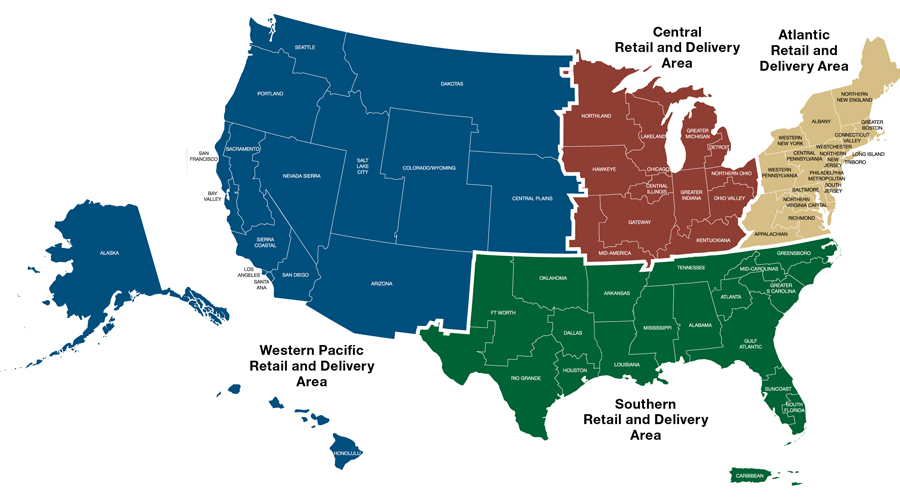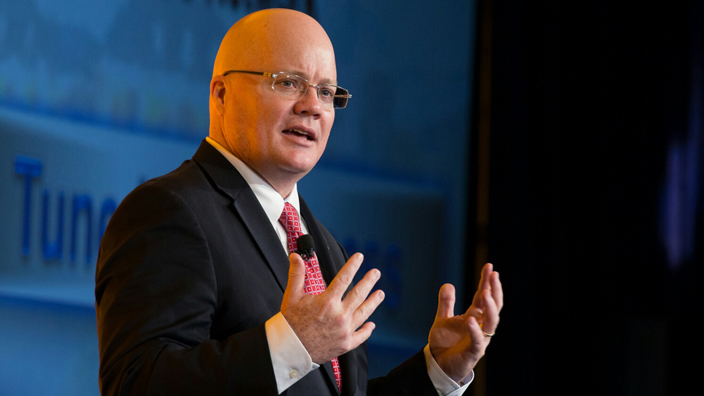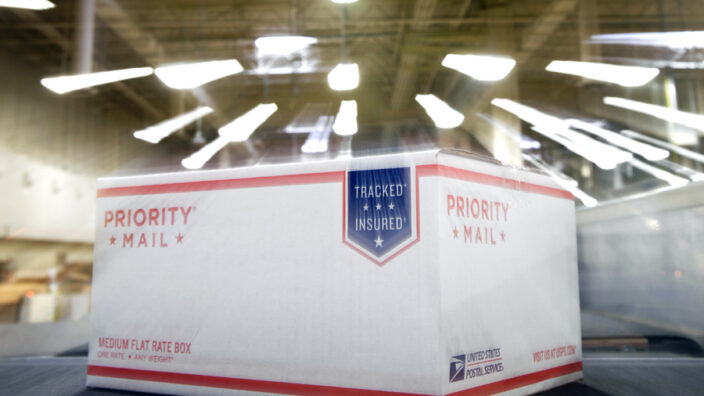How much do you know about the Postal Service’s areas and regions?
To operate more efficiently and better serve customers, the organization recently consolidated its seven delivery and retail operations areas to four: Atlantic, Central, Southern and Western Pacific.
Chief Retail and Delivery Officer Kristin Seaver oversees the areas, which focus on the acceptance and delivery of mail and packages.
Here’s what you should know about each area:
• Atlantic Area
Spans a 247,500-square-mile region in that includes the Northeast and mid-Atlantic states; led by Sal Vacca, Atlantic Area retail and delivery operations vice president
Districts: 19 (Albany, Appalachian, Baltimore, Capital, Central Pennsylvania, Connecticut Valley, Greater Boston, Long Island, New York, Northern New England, Northern New Jersey, Northern Virginia, Philadelphia Metropolitan, Richmond, South Jersey, Triboro, Westchester, Western New York and Western Pennsylvania)
Delivery points: 36 million
Employees: Approximately 169,000
Facilities: Approximately 9,000, including 8,600 Post Offices and 66 plants
• Central Area
Spans a 490,300-square-mile region that includes 10 states; led by Krista Finazzo, Central Area retail and delivery operations vice president
Districts: 13 (Central Illinois, Chicago, Detroit, Gateway, Greater Indiana, Greater Michigan, Hawkeye, Kentuckiana, Lakeland, Mid-America, Northern Ohio, Northland and Ohio Valley)
Delivery points: 33.2 million
Employees: Approximately 140,000
Facilities: Approximately 8,100, including 8,000 Post Offices and 72 plants
• Southern Area
Spans a 781,000-square-mile region that includes 11 states, as well as Puerto Rico and the U.S. Virgin Islands; led by Tim Costello, Southern Area retail and delivery operations vice president
Districts: 18 (Alabama, Arkansas, Atlanta, Caribbean, Dallas, Fort Worth, Greater South Carolina, Greensboro, Gulf Atlantic, Houston, Louisiana, Mid-Carolinas, Mississippi, Oklahoma, Rio Grande, South Florida, Tennessee and Suncoast)
Delivery points: 52.8 million
Employees: Approximately 175,000
Facilities: Approximately 8,000, including 7,900 Post Offices and 88 plants
• Western Pacific Area
Spans a 2.1-million-square-mile region that includes the Western continental states, as well as Alaska and Hawaii; led by Greg Graves, Western Pacific Area retail and delivery operations vice president
Districts: 17 (Alaska, Arizona, Bay-Valley, Central Plains, Colorado-Wyoming, Dakotas, Honolulu, Los Angeles, Nevada-Sierra, Portland, Sacramento, Salt Lake City, San Diego, San Francisco, Santa Ana, Seattle and Sierra Coastal)
Delivery points: 37.9 million
Employees: Approximately 136,000
Facilities: Approximately 7,000, including 6,900 Post Offices and 94 plants
In addition to these four areas, USPS has established two logistics and processing operations regions — Eastern and Western — that focus on processing and moving mail and packages efficiently to delivery units.
Chief Logistics and Processing Operations Officer Isaac Cronkhite oversees these regions, which are divided by the Eastern and Western halves of the United States.
Here’s more information about each:
• Eastern Region
Spans a 642,000-square-mile region that includes 22 states; led by Dane Coleman, eastern regional processing operations vice president
Divisions: Six (Chesapeake, Coastal Southeast, Lakeshores, Mid-Atlantic, New England and New York Metro)
Employees: 59,000
Facilities: 139
• Western Region
Spans a 2.3-million-square-mile region that includes 28 states; led by Larry Munoz, western regional processing operations vice president
Divisions: Six (Mid-South, Midwest, Southwest, Pacific Northwest, Southern California and Westshore)
Employees: 50,300
Facilities: 149
The USPS Areas and District Maps website has interactive maps of the areas and regions, while the usps.com Leadership page has additional information about the executives, as well as an organizational chart.



